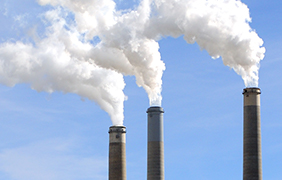Major Components: Ductwork
Ductwork connects the precipitator with upstream and downstream equipment. The design of the ductwork takes into consideration the following:
- Low Resistance to Gas Flow “ Achieved by selecting a suitable cross-section for the ductwork and by installing gas flow control devices, such as turning valves and flow straighteners
- Gas Velocity Distribution “ Gas flow control devices are used to maintain good gas velocity distribution
- Minimal Fallout of Fly Ash “ Fallout can be minimized by using a suitable transport velocity
- Minimal Stratification of the Fly Ash “ A suitable transport velocity also reduces fly ash stratification in the gas stream
- Low Heat Loss “ The goal is to reduce the heat loss of the flue gas to a level that will prevent acid or moisture condensation in the downstream equipment, requiring the use of thermal insulation protected by external siding.
- Structural Integrity “ Ductwork structure supports its total load, including wind and snow loads. The design also allows for accumulated fly ash, negative/positive operating pressure, and gas temperature. Expansion joints are used to accommodate thermal growth.
Helpful Resources
KnowledgeBase: Gas Distrbution Systems
KnowledgeBase: Improve Flow Distribution
KnowledgeBase: Introduction to ESP
Our Capabilities: Emissions Compliance Planning & Management
Our Capabilities: Gas Flow & Fluid Dynamics Modeling


